U-V-W-X-Y-Z
| refers to 3/4 inch magnetic tape, originally a professional cassette tape format now being supplanted by new digital formats; a competing tape format was the inferior 1/2" VHS or beta | ||
| a 'supporting' role for a major (sometimes minor) star that is officially credited (usually in the end credits), but no mention (or billing) is made in the film's advertisements or the opening credits; contrast with cameo and uncredited role. | Examples: Harold Russell in The Best Years of Our Lives (1946), Bill Murray in Tootsie (1982), Jack Nicholson in Broadcast News (1987), Gene Hackman in The Firm (1993) | |
| a role that a major (or minor) star plays that is not credited in the credits or in the film's poster; contrast with cameo and unbilled role. | Examples: Tim Robbins' screen debut in the role of Peter Finch’s assassin in Sidney Lumet’s Network (1976); Elsa Lanchester, credited as Mary Shelley, but uncredited for the role of the Bride ("the Monster's Mate") in Bride of Frankenstein (1935); Mildred Dunnock as the wheelchair bound old lady in Kiss of Death (1947) pushed down a flight of stairs by Richard Widmark | |
| refers to an understated, neutral and muted acting performance; contrast with overacting | Example: Bruce Willis in Shyamalan's Unbreakable (2000) | |
| refers to the slowing down of the frame rate of a camera, by shooting at less than the standard 24 fps, so that the captured image, when normally projected, will appear to be in fast motion; often used to produce a comic effect | ||
| refers to a film shot that has less light than normal, causing an indistinct, dimly-lit, unclear image lacking contrast; the opposite of overexposed | ||
| a low-budget, non-commercial film, usually independently-made, without the traditional sources of funding or distribution | ||
| organizations that represent professionals in the motion picture industry (e.g., directors, actors, writers, etc.), and help those individuals negotiate contracts, receive recognition, pursue rights, protect interests, etc.; aka guilds | Examples: DGA (Directors Guild of America), WGA (Writers Guild of America), SAG (Screen Actors Guild), ASC (American Society of Cinematographers), etc. | |
| A literary term meaning a protagonist or narrator whose perspective is skewed to their own perspective, producing a portrayal of events that may or may not be accurate or truthful; the lack of credibility may be deliberate or due to a lack of knowledge | Examples: Rashomon (1950, Jp.) - four protagonists communicated completely different perspectives on the same incident; in the twist ending of The Usual Suspects (1995), Verbal Kint's (Kevin Spacey) description of events was revealed to be deliberately misleading; in Memento (2000), the lead character, suffering from severe amnesia, provided a very unreliable narrative | |
| a slang term meaning to screen or show a film | ||
| refers to an imaginary, ideal (or mythical), perfect state or place (especially in its laws, government, social and moral conditions), often with magical healing, restorative properties; see also its opposite - dystopia | Example: Shangri-La in Lost Horizon (1937) | |
| a femme fatale or woman with a bad reputation, usually seductive and scheming in nature or behavior. |
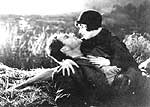 Examples: the temptress (Margaret Livingston) from the City in Sunrise (1927); Theda Bara was the first to be labeled a vamp in A Fool There Was (1914) Examples: the temptress (Margaret Livingston) from the City in Sunrise (1927); Theda Bara was the first to be labeled a vamp in A Fool There Was (1914) |
|
| a respected, oft-quoted show-biz periodical or trade paper (or one of the trades) that reports and provides coverage on the entertainment industry (including the film industry), and best known for its goofy, shorthand 'Varietyese' headlines, using made-up words, e.g. 'dee jay' (disc jockey), or 'B.O.' (box office or boffo) |  Examples: Two infamous, jargon-filled Variety headlines: (1) "Wall Street Lays an Egg", referring to the Stock Market crash, and (2) "Hix Nix Stix Pix" - referring to inhabitants of the Heartland criticizing films depicting rural American life and rural themes Examples: Two infamous, jargon-filled Variety headlines: (1) "Wall Street Lays an Egg", referring to the Stock Market crash, and (2) "Hix Nix Stix Pix" - referring to inhabitants of the Heartland criticizing films depicting rural American life and rural themes |
|
| a stage variety entertainment show, featuring a series of short acts - songs, dancing, acrobatics, comedy skits, and animal acts; it was highly popular in America from the late 1880s to the 1920s, when it became overtaken by sound films and radio; most of the early film, radio and TV comedians found their start on the vaudeville circuit. | Examples: vaudeville performers included W. C. Fields, Buster Keaton, the Marx Brothers, Edgar Bergen and The Three Stooges. Abbott and Costello's vaudeville act 'Who's on First?' was adapted from stage to screen. The Catskill Mountains in New York and the Poconos in Pennsylvania were holdovers from the vaudeville era late into the 70's | |
| literally, 'Video-Cassette Recorder'; aka VTR (video tape recorder); a consumer-level machine for home entertainment that plays-back and records images and sounds from TV on magnetized tape in a videotape cassette; VHS stands for 'Video Home System' or the 1/2 inch video cassette tape format; see also U-matic or beta | ||
| refers to a camera technique created by tracking backwards while simultaneously zooming in, making the person or object in the center of the image seem stationary while their surroundings change; aka contrazoom | 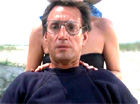 Example: Alfred Hitchcock's bell-tower sequence in Vertigo (1958) to approximate the dizzying vertigo feeling of the main character (see zoom shot); also the beach scene in Jaws (1975) when Police Chief Brody saw danger in the water (pictured here) Example: Alfred Hitchcock's bell-tower sequence in Vertigo (1958) to approximate the dizzying vertigo feeling of the main character (see zoom shot); also the beach scene in Jaws (1975) when Police Chief Brody saw danger in the water (pictured here) |
|
| literally, "to see," in other words, the visual or pictured image (either projected, taped, etc.), as opposed to the audio aspect of film; also refers to the visual component of television; digital videorefers to a video signal represented by a series of binary numbers that are readable by computer - compare with analog video; aka vid (for short) | ||
| a British term from the 1980s that refers to a select group of ultra-violent videos (low-budget films produced in Italy and the US) that were considered highly objectionable and to be regulated | 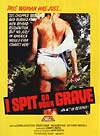 Examples: 72 separate films appeared on the classified list of "video nasties," 39 of which were successfully prosecuted. Films included Blood Feast (1963), Cannibal Holocaust (1980), The Evil Dead (1981), Faces of Death (1980), I Spit On Your Grave (1978), The Last House on the Left (1972), andTenebrae (1982). Examples: 72 separate films appeared on the classified list of "video nasties," 39 of which were successfully prosecuted. Films included Blood Feast (1963), Cannibal Holocaust (1980), The Evil Dead (1981), Faces of Death (1980), I Spit On Your Grave (1978), The Last House on the Left (1972), andTenebrae (1982). |
|
| usually a type of action film in which the protagonist takes the law into his/her own hands as a self-appointed doer of justice, revenge, and payback. | Examples: Billy Jack (1971), Walking Tall (1973), Death Wish (1974), Foxy Brown (1974), Taxi Driver (1976), Rolling Thunder (1977), The Road Warrior (1981), Falling Down (1993), Kill Bill, Vol. 1-2 (2003-04) | |
| a scene in a film that can stand on its own; also refers to a masking device, often with soft edges. |
 Example: the "Tara" scene from Gone With the Wind (1939) in which Scarlett O'Hara (Vivien Leigh) declares: "I'll never be hungry again...", or Sally's 'orgasm' scene in a deli in When Harry Met Sally...(1989) Example: the "Tara" scene from Gone With the Wind (1939) in which Scarlett O'Hara (Vivien Leigh) declares: "I'll never be hungry again...", or Sally's 'orgasm' scene in a deli in When Harry Met Sally...(1989) |
|
| considered a sub-category of special effects; refers to anything added to the final picture that was not in the original shot; visual effects can be accomplished in-camera (like stop motion, double exposures and rear/front projection) or via a number of different optical or digital post-production processes (CGI, for example), usually with a computer | ||
(or v.o.) |
refers to recorded dialogue, usually narration, that comes from an unseen, off-screen voice, character or narrator (abbreviated as o.s. meaning beyond camera range), that can be heard by the audience but not by the film characters themselves; narrationis a type of voice-over; v.o. often conveys the character's thoughts, either as a 'voice' heard within one's head, or as other narrative information and commentary to explain the action or plot; often a technique in film noirs; the abbreviation is used as an annotation in a script | 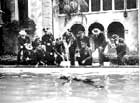 Examples: Capt. Willard's voice-overs in Apocalypse Now (1979), Deckard's v.o. in Hollywood's version of Ridley Scott's Blade Runner (1982), the mortally wounded hero's flashback narration in Double Indemnity (1944), or the voice-over narrated by the dead man floating in a pool in the opening of Sunset Boulevard (1950) (pictured here) Examples: Capt. Willard's voice-overs in Apocalypse Now (1979), Deckard's v.o. in Hollywood's version of Ridley Scott's Blade Runner (1982), the mortally wounded hero's flashback narration in Double Indemnity (1944), or the voice-over narrated by the dead man floating in a pool in the opening of Sunset Boulevard (1950) (pictured here) |
| this film term was named after Serbian-American film director/editor Slavko Vorkapich; the term 'vorkapich' was popularized in screenplays of the 1930s and 1940s - it meant a montage sequence, that Vorkapich himself called "symphonies of visual movement" | Examples: Vorkapich's own montage sequences were seen in the Mexican Revolution outbreak in Viva Villa! (1934), the earthquake montage in San Francisco (1936), the famine disaster in The Good Earth (1937), and in Capra's Mr. Smith Goes to Washington (1939) in the ultra-patriotic montage of the whirlwind sightseeing bus tour of Washington DC including the Lincoln Memorial, and Meet John Doe (1941) | |
| a minor role consisting of a single, brief appearance on the screen, usually not appearing in the credits and without dialogue; contrast with extras, bit parts, and non-speaking roles. | ||
| the first rehearsal on the set, to figure out lighting, sound, camera positioning, etc. | ||
| refers to the atmospheric, background sound effect for the indistinct murmurings and buzz of voices in a crowd; extras in crowd scenes, in older films (or in radio), would be asked to murmur a phrase ('walla walla,' 'rhubarb,' 'peas and carrots,' or 'watermelon,' etc.) to create the sound of the crowd and to pretend that they were talking; see also foley artist, dubbing, and non-synchronized sound | ||
| the general name for the costume department, or the costumes (and their accessories) themselves; see also costume | ||
| refers to the object that motivates the main action in a serial (e.g., a lost city, buried treasure, or missing plans, etc) | ||
|
in early film production, an individual on a film set's sound stage who was employed to make sure all noises were "shushed" before filming. The whistleman would blow on a whistle just before the shooting of a take commenced, to make sure that the set was quiet and that extraneous noises near or outside the studio set were silenced. |
||
| refers to electronically setting or 'color-correcting' a camera's white balance - or the true color of white, since white doesn't appear 'white' with all lighting conditions | ||
| refers to a mystery/detective film | 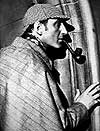 Example: The major or lead character in a whodunit is a crime-solving detective, such as in the Sherlock Holmes series of films Example: The major or lead character in a whodunit is a crime-solving detective, such as in the Sherlock Holmes series of films |
|
| in sound effects, this refers to the extra noises added to a sound, e.g., bells, horns, or whistles to an explosion, to make it more interesting or exciting | ||
| a shot (often abbreviated WS) taken with a lens that is able to take in a wider field or range of view (to capture more of the scene's elements or objects) than a regular or normal lens; a wide-angle shot exaggerates the distance, depth or disparity between foreground and background planes, thereby creating greater depth-of-field and keeping all objects in focus and in perspective; an extreme or ultra-wide-angle lens giving a 180 degree view is called a 'fish-eye' lens | 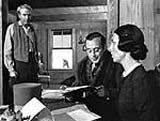 Example: In Citizen Kane (1941), the famous wide-angle scene in Mrs. Kane's boardinghouse that kept all objects in the shot in sharp focus Example: In Citizen Kane (1941), the famous wide-angle scene in Mrs. Kane's boardinghouse that kept all objects in the shot in sharp focus |
|
| refers to projection systems in which the aspect ratio is wider than the 1.33:1 ratio that dominated sound film before the 1950s; in the 1950s, many widescreen processes were introduced (to combat the growing popularity of television), such as CinemaScope (an anamorphic system), VistaVision (a non-anamorphic production technique in which the film is run horizontally through the camera instead of vertically), and Todd-AO and Super Panavision (that both used wider-gauge film); also known as letterboxing | 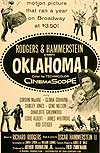 Examples: Oklahoma! (1955), and Around the World in Eighty Days (1956) Examples: Oklahoma! (1955), and Around the World in Eighty Days (1956) |
|
| a red warning light located above each entrance-exit door on a film set sound stage, designed to flash (with a buzzer sound) to indicate when shooting commences or ends; also known as "red-eye" | ||
| a transitional technique or optical effect/device in which one shot appears to be "pushed off" or "wiped off" the screen by another shot replacing it and moving across the existing image; also called a push-over; a flip-over (or flip) wipe is when one scene rotates or flips-over to the new scene; wipes were very commonly used in the 30s |  Example of a wipe right, often used in various Star Wars films. |
|
| a term referring to the public discussion or buzz that a film can acquire, fueled by sneak previews and advance advertising; word of mouth is an important marketing element in a film's success or failure - positive word of mouth gives a film legs, while negative word of mouth may prematurely close it down | Examples: The Hulk (2003) opened with $62 million but fell 69.7% by its second weekend, due in part, to negative word of mouth, whereas Disney's Finding Nemo (2003) had incredible word-of-mouth and staying power over many weeks; A Fish Called Wanda (1988) also had a prolonged period of positive word-of-mouth during its initial opening | |
| refers to the completion of film shooting (either for the day or for the entire production or project); in the early days of cinema, the cameraman would say after filming: "Wind, Reel, And Print' - abbreviated as WRAP; a entirely completed film is termed in the can | ||
| refers to the individual who authors the content of the piece from pre-existing material or uses an entirely new idea; usually there are many writers involved with re-writes, adaptations, character development, etc.; aka screenwriter | ||
| a slang term, meaning a boring film | ||
Z-movie |
refers to a very low-budgeted, independently-made, non-union, less than B-film grade movie, usually with first-time director and actors; often quickly-made for the teenaged youth market and amateurish-looking, but with campy appeal; with exploitational subject matter that includes surfing films, motorcycle flicks, cheap horror films, etc.; Z-films become prime candidates for cult film status |
|
| a single shot taken with a lens that has a variable focal length, thereby permitting the cinematographer to change the distance between the camera and the object being filmed, and rapidly move from a wide-angle shot to a telephoto shot in one continuous movement; this camera technique makes an object in the frame magnify and appear larger; the movement towards a subject to magnify it is known as zoom in or forward zoom, or reversed or decreased to reduce its size is known as zoom out/back or backward zoom |
 Example: Hitchcock's much-imitated, dizzying, and unsettling Hitchcock-zoom (or contra-zoom, or zolly) in Vertigo (1958) using a combination zoom in and dolly back or dolly-out, resulting in a dramatic change in perspective; the camera tracked in one direction while zooming in the opposite direction, causing an apparent "lengthening" of distance down the stairway; also in Jaws (1975) when Chief Brody (Roy Scheider) seated on-shore looked out at the bloody shark attack in the water, and the restaurant scene in Goodfellas (1990) when Henry Hill (Ray Liotta) realized that Jimmy Conway (Robert De Niro) was betraying him and setting him up Example: Hitchcock's much-imitated, dizzying, and unsettling Hitchcock-zoom (or contra-zoom, or zolly) in Vertigo (1958) using a combination zoom in and dolly back or dolly-out, resulting in a dramatic change in perspective; the camera tracked in one direction while zooming in the opposite direction, causing an apparent "lengthening" of distance down the stairway; also in Jaws (1975) when Chief Brody (Roy Scheider) seated on-shore looked out at the bloody shark attack in the water, and the restaurant scene in Goodfellas (1990) when Henry Hill (Ray Liotta) realized that Jimmy Conway (Robert De Niro) was betraying him and setting him up |
|
| a revolutionary special effects, 3-D process invented by cameraman Zorian Perisic, incorporating a camera system and a projector with synchronized zoom lenses, to create the illusion of movement in depth | Example: the unique flying sequences of the Man of Steel in the first two Superman movies and in Disney's Return to Oz (1985), in which a projected background scene remains constant while the camera zooms in on the foreground subject | |
źródło:www.filmsite.org
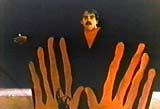 Examples: American International Pictures specialized in Z-films, such as Count Yorga, Vampire (1970), Roger Corman's Gas-S-S-S! (1971) (aka (Gas! Or It Became Necessary to Destroy the World in Order to Save It), and The Incredible 2-Headed Transplant (1971); also Octaman (1971), Invasion of the Bee Girls (1973), and The Curse of the Screaming Dead (1982). The best known Z-film, Manos, The Hands of Fate (1966) (pictured), was an extreme low-budget film made by fertilizer salesman Hal P. Warren, a film that became famous by the satirical TV show Mystery Science Theater 3000; also, director Ed Wood's films were Z-pictures, such as Plan 9 From Outer Space (1959), as was Vic Savage's The Creeping Terror (1964) and Fred Olen Ray's Attack of the 60-Foot Centerfold (1995) and Bikini Cavegirl (2004) (aka Teenage Cavegirl)
Examples: American International Pictures specialized in Z-films, such as Count Yorga, Vampire (1970), Roger Corman's Gas-S-S-S! (1971) (aka (Gas! Or It Became Necessary to Destroy the World in Order to Save It), and The Incredible 2-Headed Transplant (1971); also Octaman (1971), Invasion of the Bee Girls (1973), and The Curse of the Screaming Dead (1982). The best known Z-film, Manos, The Hands of Fate (1966) (pictured), was an extreme low-budget film made by fertilizer salesman Hal P. Warren, a film that became famous by the satirical TV show Mystery Science Theater 3000; also, director Ed Wood's films were Z-pictures, such as Plan 9 From Outer Space (1959), as was Vic Savage's The Creeping Terror (1964) and Fred Olen Ray's Attack of the 60-Foot Centerfold (1995) and Bikini Cavegirl (2004) (aka Teenage Cavegirl)